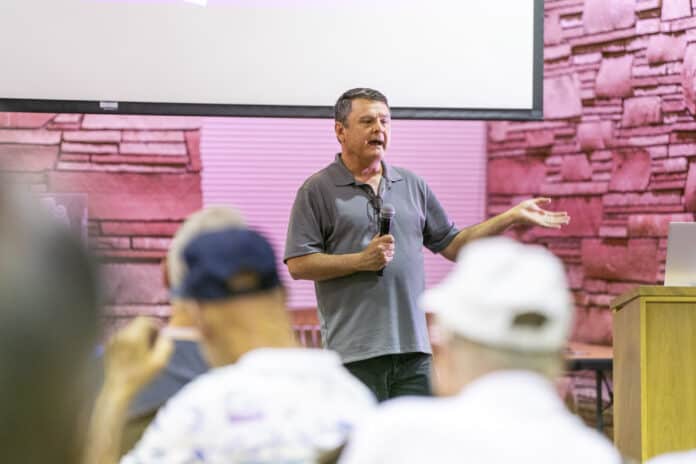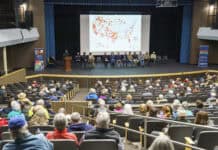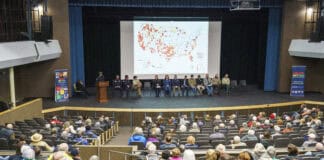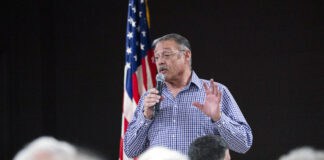
“This is a horror story, this is a descent into hell. I feel incredibly proud to be entrusted enough to tell that story,” Village of Oak Creek author Tracy Derks said about his recently released book “Particular Bravery: The Battle of Xa Cam My and the Death of a Grunt Company” during the Veterans History Project’s monthly Coffee With a Veteran program at the Sedona Public Library on Friday, June 9.
Derks was 6 years old in 1965 when his half-brother Raymond Long was deployed to Vietnam with the 1st Infantry Division.
“He was my hero and always [has] been my hero,” Derks said. ”My mother was a nervous wreck in 1966, my mother slipped up and let me watch the news. The news said there were people in Vietnam who wanted to kill him. I didn’t understand that because he is a great guy. That is what got me interested in history. I have a degree in history … and teach it online at the American Military University [to] active duty and veterans all over the world.”
Derks has written numerous stories about 20th-century warfare, but the Battle of Xa Cam My, also known as Operation Abilene, is one that he has been researching since he wrote a master’s thesis on it at Sam Houston State University in 2005. His research began with the stories of Sgt. James Robinson Jr., who received the Medal of Honor for his actions during the battle in 1967, and Airman William H. Pitsenbarger, who received his decades later in 1999.
Operation Abilene was intended to disrupt the Viet Cong’s offensive against Saigon. In an attempt to accomplish this, Gen. William DePuy had infantry companies patrol the jungles to identify artillery targets, stating “The solution in Vietnam is more bombs, more shells, more napalm … until the other side cracks and gives up.” In the spring of 1966, Charlie Company, 2nd Battalion, 16th Infantry was assigned to hunt for the Viet Cong D800 battalion.
On the afternoon of Easter Sunday, April 11, 1966, 40 miles east of Saigon near the village of Xa Cam My, the 130 men of Charlie Company were spotted by Viet Cong scouts. Over the next day, 80% of those American soldiers were either killed in action or severely wounded.
Derks said that Charlie Company was facing several disadvantages going into the battle. The U.S. Army knew that the Viet Cong had the advantage and that their forces were outnumbered, cut off from support and had an inexperienced commander, their third in six weeks, leading a company that was half composed of men who had been in Vietnam for less than a week. DePuy’s intention, however, was to use the company as bait to lure the D800 battalion out of the jungle.
“As the battle continued and casualties mounted, Robinson moved under intense fire to collect from the wounded their weapons and ammunition and redistribute them to able-bodied soldiers,” Robinson’s Medal of Honor citation read.
“Seeing another wounded comrade in front of his position, Robinson again defied the enemy’s fire to rescue [him]. In so doing he was wounded … Despite his wounds, he dragged the soldier to shelter and saved his life. While patching his wounds, he spotted an enemy machine gun which had inflicted casualties on the American force. His rifle ammunition expended, he seized two grenades and charged toward the entrenched enemy weapon. Hit again in the leg, with a tracer round which set fire to his clothing … sustaining two additional chest wounds, he marshaled his physical strength and hurled the two grenades, thus destroying the enemy gun position, as he fell dead upon the battlefield.”
“[He] was aboard a rescue helicopter responding to a call for evacuation of casualties,” Pitsenbarger’s Medal of Honor citation stated. “With complete disregard for personal safety, Pitsenbarger volunteered to ride a hoist more than 100 feet through the jungle to the ground. On the ground, he organized rescue efforts, cared for the wounded, prepared casualties for evacuation and insured that the recovery operation continued in a smooth and orderly fashion. Through his efforts, the evacuation of the wounded was greatly expedited … Pitsenbarger refused evacuation to get more wounded to safety.”
Pitsenbarger died in the firefight after the Viet Cong breached Charlie Company’s defensive perimeter.
“They believed in what they were doing at this point in the war,” Derks said. “They were fighting communism, they were doing their duty. I think that’s important because there’s so many stories about Vietnam that are not about patriotism.”
Coffee With a Veteran takes place on the second Friday of the month at 10 a.m. in the Si Birch Community Room at the Sedona Public Library.


















